Best Backup Backstops in Miami Marlins History
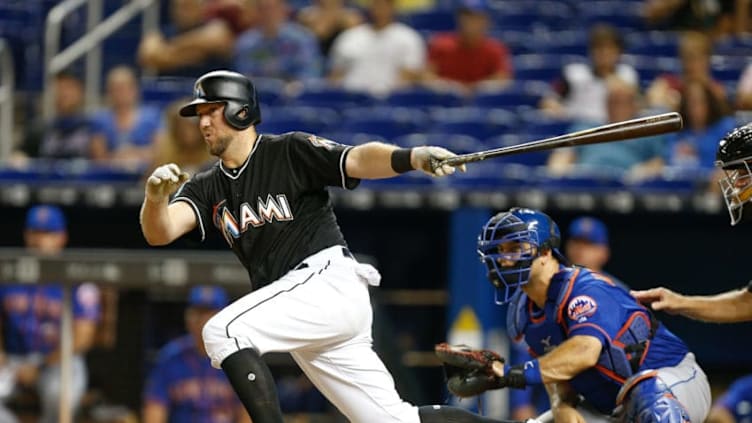
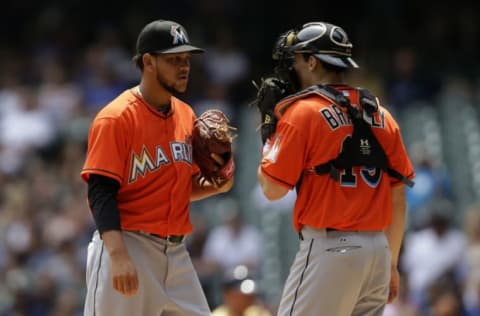
Through Miami Marlins history, 46 different men have called pitches for the assorted fireballers on the mound. Some more, some less, but all major leaguers, in the end.
It takes a special kind of ballplayer to squat for the better part of half of three hours every day during half of the calendar year. And those men need a break sometimes. Enter the mighty backup catcher. The ranks of “backup catcher” are loaded with has-beens, never-was’s, coulda, shoulda, but for whatever reason weren’t primary catcher material. Which Miami Marlins backup catchers stand out in your mind?
J.T. Realmuto, Jarrod Saltalamacchia, John Buck, John Baker, Miguel Olivo, Paul Lo Duca, Ivan Rodriguez, Charles Johnson, Gregg Zaun, and Benito Santiago spent most of their tenure with the Florida and Miami Marlins as the “primary” catcher. These 10 are exempt from our thought experiment. Which “backup” catchers stood (squatted) above the rest?
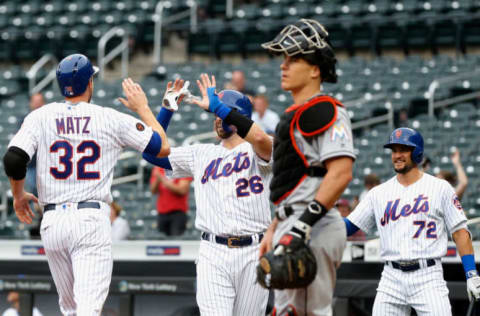
Just Missed
Taking out our primary catchers has left us with 36 choices, so lets eliminate those who barely registered a blip on the Baseball Reference database (as a Miami Marlin).
Less than 30 games
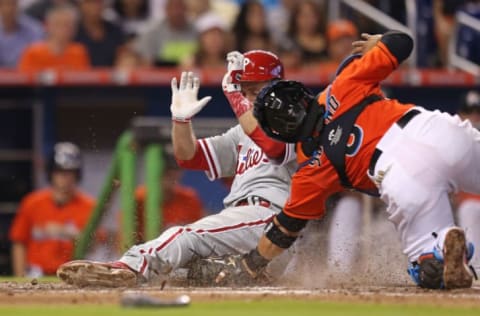
Greg O’Halloran 1
Mike Mordecai 1
John Roskos 1
Kyle Skipworth 1
Mitch Lyden 2
Terry McGriff 3
Guillermo Garcia 3
Ryan Jorgensen 3
Mike Piazza 4
Chris Hatcher 4
Mike Rivera 5
Jhonatan Solano 6
Sandy Martinez 9
Chad Wallach 14
Tomas Telis 15
Randy Knorr 15
Josh Willingham 15
Koyie Hill 18
Ron Tingley 18
Joe Siddall 18
Paul Hoover 19
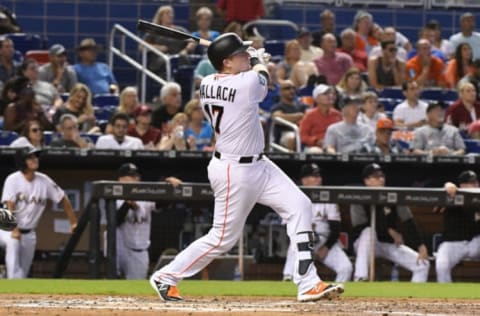
This narrows the field down to 15. Of course, Wallach and Telis may have more of a say in the future, but the most of the rest have already retired. Willingham and Mordecai had long careers outside of their time behind the plate for the Marlins. Hatcher switched positions and is currently pitching for the Oakland Athletics. Piazza is a Hall-of-Fame catcher, but four games isn’t enough to make this list, and if I remember correctly, during his week in Florida, he was not considered the backup.
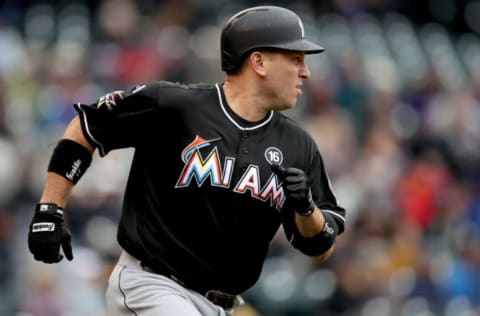
Honorable Mentions
A.J. Ellis
A.J. Ellis threw out 33 percent of basestealers in 39 contests at catcher for the Miami Marlins in 2017. Of the 15 remaining players on the list, he had the third highest slugging percentage, weighing in with a .210/.298/.371 slashline, six home runs, and 14 RBI.
Brett Hayes
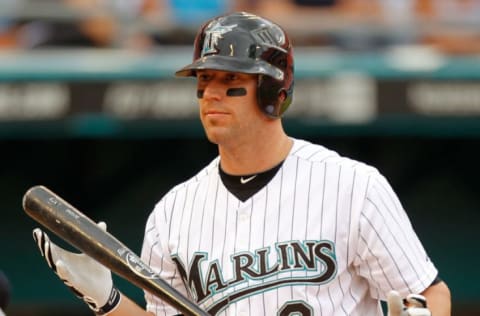
Brett Hayes caught in 107 of his 143 appearances with the Florida and Miami Marlins from 2010 through 2012. Through his first two seasons, he had zero errors in over 500 innings of work before booting it five times in 33 games in 2012. Hayes threw out 26 percent of runners and posted a .217/.266/361 slashline during his stay with Florida/Miami.
Brad Davis
Brad Davis played in 33 games for the Florida Marlins in 2010, slashed .211/.270/.376, and popped three homers with 16 RBI. Defensively, he threw out seven-of-26 baserunners.
Mike Rabelo
Mike Rabelo was the backup catcher on the 2008 Florida Marlins, on a team that had three catchers appear in at least 32 games but none over 65. He posted the highest fielding percentage, at .995, and the best CS rate, coming in at 27 percent. He put up a .202/.256/.294 slashline in his 34 total contests.

Steve Decker
Steve Decker played in a handful of games for the 1993 Marlins, but didn’t serve as the “primary” backup until 1995. He threw out 32 percent of basestealers, just above the National League average, and slashed out a .226/.318/.323 line by showing a lot of patience at the plate.
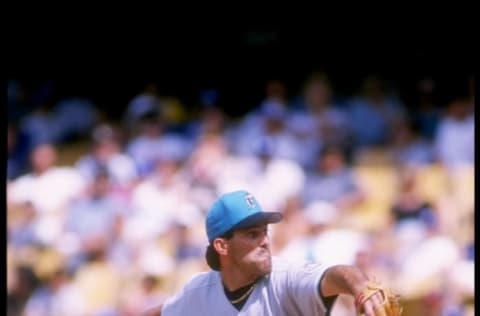
10. Rob Natal
After coming up with the Montreal Expos, Rob Natal joined the inaugural version of the Florida Marlins via expansion draft, and appeared behind the plate at least a few times a season for the first five seasons of Miami baseball. He was most prolific through his 1993 season despite not acquiring the requisite at bats to lose his rookie status. That’s when he got into 41 games and went 25-for-117 from the plate, with one home run, six RBI, and a 32 percent CS rate which matched exactly the NL rate. He also handled 281 2/3 innings of work without an error, providing valuable backup to former all-star Benito Santiago.
Throughout his Marlins career, Natal earned a .986 fielding percentage, rang up 28-of-93 basestealers, and slashed a .201/.282/.300 line over 115 games. He was also the Marlins primary backup in 1996, for all-star Charles Johnson.
9. Rob Brantly
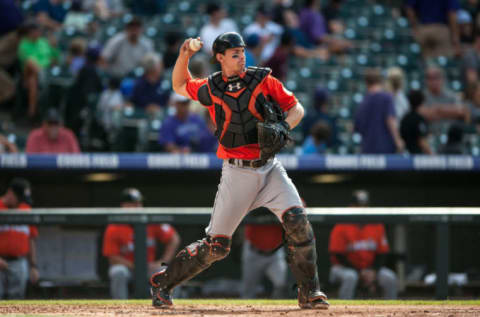
Rob Brantly was drafted all the way down in the 46th round in 2008, by the Washington Nationals. Two years later, the Detroit Tigers spent a third round selection on him. Two years after that, they traded him to the Miami Marlins for Anibal Sanchez and Omar Infante (we also got Jacob Turner and Brian Flynn in that deal).
In 2012, Brantly served as one of two backups to incumbent John Buck, along with Brett Hayes. Brantly only threw out 18 percent of baserunners, although he was a solid pitch caller and fielder (.990 fielding percentage). In 2013, he split nearly equal time with nominal starter Jeff Mathis (more on him later). Brantly improved to a 28 percent CS rate, and again racked up a .990 fielding percentage.
The backup catcher is almost never known for his bat, and Brantly is no exception to the rule. He put together a .235/.298/.325 slashline in 98 games for the Marlins. That’s actually amongst the top third of the slashlines for the final 15 catchers in this article.
8. Bryan Holaday
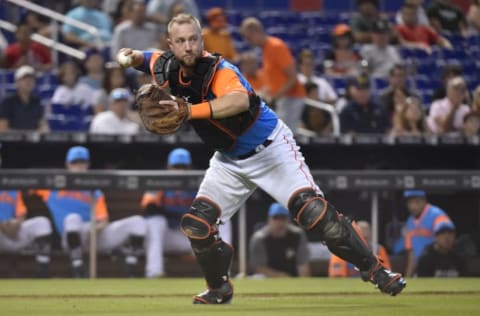
Fans of the 2018 Miami Marlins, few though they may be, have come to appreciate Bryan Holaday as a primo backup catcher. After coming up through the Detroit Tigers system, he also played with the Texas Rangers and the Boston Red Sox. The Marlins signed him to a one-year, $1,000,000 deal last offseason.
Sure, Holaday didn’t hit very good. He slashed a .205/.261/.258 through the season, with one home run and 16 RBI. He did account for two walkoff hits (see below) and even pitched twice. Who could ever forget when he struck out Rhys Hoskins looking at a 62 MPH junkball?
Holaday’s real value was in his defense. He played 357 1/3 innings of errorless ball, was only charged with one passed ball, and threw out a staggering 45 percent of opposing baserunners trying to steal, brave souls. He handled the staff effectively, called a good game, and frames pitches with the best of them. Another season backing up J.T. Realmuto would see him move considerably up this particular list.
7. Ramon Castro

Ramon Castro carved out a nice little 13-season major league career, and it all started with the 1999 Florida Marlins.
Over his six seasons with the Fish, Castro effectively backstopped 163 contests. Starting in 1999, he was one part of the three-headed catching monster, with Jorge Fabregas and Mike Redmond. 2000 would see more of the same, except Fabregas was replaced by Paul Bako. More on all three of them later in this article.
Castro turned in a perfect defensive season in 2002, catching 203 1/3 innings with a 1.000 fielding percentage, no passed balls, and a 30 percent CS rate backing up Charles Johnson and Redmond. The World Series Champion version of the Marlins would see him back up Ivan Rodriguez and Redmond, although he only got into 18 games.
The interesting thing about Castro is that in all of his six years with the Marlins, he was always third in time played at catcher. So I guess he would be number one in an article about the backup to the backup catcher. Castro put together a .212/.296/.265 slashline with 18 home runs and 53 RBI in 207 contests in total. He threw out 94-of-315 trying to steal during his time, good for a 30 percent kill rate.

6. Jorge Fabregas
Jorge Fabregas was a first-rounder for the California Angels back in 1991. After working his way up through their system, he made his debut in Anaheim in 1994, then played there until 1997. After a few personnel moves that saw him spend time with the Chicago White Sox, the Arizona Diamondbacks, and the New York Mets, he made his way to the Marlins via trade for Oscar Henriquez after the 1998 season.
Fabregas played in 82 games for the Marlins, and in all honesty was likely considered the top catcher on the depth chart during his time with the team. He caught in 78 of those games, earning a .989 fielding percentage and throwing out a staggering 45 percent of runners trying to steal, or 30-of-67. At the plate, Fabregas hit three home runs and collected 21 RBI, with a .206/.289/.309 slashline.
On August 26th, 1999, the Florida Marlins released Fabregas, where he was immediately picked up by the Atlanta Braves. He later appeared in the majors with the Kansas City Royals, the Angels, and the Milwaukee Brewers.

5. Paul Bako
Paul Bako was drafted in the fourth round by the Reds in 1993, and worked his way up to the majors by 1995 with the Detroit Tigers.
A true journeyman in the literal sense of the word, Bako also played major league ball with the Houston Astros, the Atlanta Braves, the Milwaukee Brewers, the Chicago Cubs, the Los Angeles Dodgers, the Kansas City Royals, the Baltimore Orioles, the Reds, and the Philadelphia Phillies.
The Florida Marlins purchased Bako’s contract from the Astros on April 11th, 2000. He went on to appear at catcher for the Marlins in 56 contests, with a halfway decent (for a backup catcher) slashline of .242/.335/.292. Defensively, Bako earned a .991 fielding percentage and threw out 35 percent of basestealers, three percent above the National League average. On June 12th, Bako drew a walk, hit a two-RBI-triple, and doubled to right field in a 5-2 win against the Phillies. On July 21st the Marlins placed Bako on waivers. So in Bako’s only season with Florida, he neither began nor ended the year with the Marlins.

4. Matt Treanor
Matt Treanor took the scenic route to the major leagues. A fourth round draft pick of the Kansas City Royals back in 1994, he didn’t make his big league debut until 2004 with the Florida Marlins at the age of 28. Despite taking forever to get to the top level of baseball, Treanor carved out a nice little nine-season major league career after getting there. On June 17th, in the fifth game of his career, he hit a walkoff RBI-single to score Luis Castillo, defeating the Chicago White Sox, 2-1.
For the first five of those seasons, Treanor backstopped for the Marlins. He was the primary backup of Paul Lo Duca in 2005, Miguel Olivo in 2006 and 2007, and split the catching duties more-or-less evenly in 2008 with John Baker.
Treanor allowed 139 stolen bases in 261 contests, and threw out 50 baserunners for a 23 percent kill rate. That’s hardly elite, but in 2006, that’s exactly what he was. He gunned down an NL leading 47 percent of basestealers in that season, nailing 16-of-34.
As a hitter, Treanor was better than the average backup, and slashed a .238/.306/.301 line in 274 contests overall. He collected eight home runs and 70 RBI.
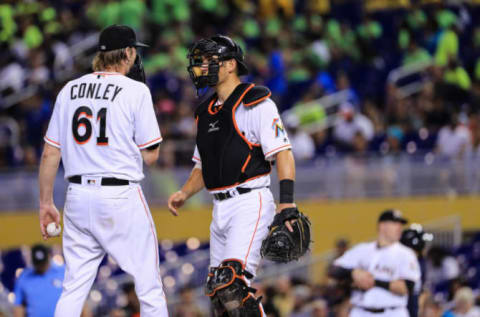
3. Jeff Mathis
Jeff Mathis was a first round selection of the Anaheim Angels in 2001. He made his major league debut with them in 2005 after working his way up through their system, then played seven seasons for them in the majors. After spending 2012 with the Toronto Blue Jays, he was traded to the Miami Marlins with Henderson Alvarez, Anthony DeSclafani, Yunel Escobar, Adeiny Hechavarria, Jake Marisnick, and Justin Nicolino for Emilio Bonifacio, John Buck, Mark Buehrle, Josh Johnson and Jose Reyes.
Mathis had never hit higher than .211 in his first eight major league seasons, and his four seasons with the Marlins would yield few surprises on that front. He slashed .195/.252/.292 in 210 games in total, with 11 round trippers and 68 RBI. He did sometimes have a flair for the dramatic.
Mathis was the nominal starter for the Miami Marlins in 2013, splitting time nearly evenly with Rob Brantly. In 2014 he backed up Jarrod Saltalamacchia, and after that was J.T. Realmuto’s relief. A crafty pitch caller and above average pitch framer, Mathis appeared in 203 games behind the plate for the Fish. He made six errors in 1644 2/3 innings for a .996 fielding percentage, only passed nine balls, and threw out baserunners at a better-than league average clip, with a 32 percent kill rate.
The Marlins granted free agency to Mathis after the 2016 season, and he inked a deal to play for the Arizona Diamondbacks.

2. Ronny Paulino
Ronny Paulino signed with the Pittsburgh Pirates back in 1997, and patiently worked his way up until making his debut with the Bucs in 2005. After four seasons in the Steel City, he was traded three times between the end of 2008 until the beginning of 2009, with “stops” in Philadelphia and San Francisco. The Giants sent him to the Marlins for Hector Correa just prior to the start of the 2009 season.
Paulino spent the 2009 season backing up John Baker, and got into 80 games, 77 of them as catcher. He made only two errors in 582 1/3 innings of work, and threw out 31 percent of basestealers. He was also sneaky-good at picking runners off (see above). Offensively, he was much better than the standard backup catcher, slashing .272/.340/.423 with eight home runs and 27 RBI. On August 26th, he hit a two-run homer, the eventual game-winner, to take a 4-2 fifth inning lead over the New York Mets. The Marlins eventually won that one, 5-3, and Paulino’s .301 WPA was the highest he earned through the season in a win.
In 2010, Paulino started most of the games for the Marlins. He started 84 times, while five other catchers backed him up, with none of them starting more than 32 times. Paulino notched a .991 fielding percentage and again threw out 31 percent of baserunners trying to steal, and slashed a respectable .259/.311/.354 with four homers and 37 RBI.
Granted free agency after the 2010 season, Paulino signed on with a number of major league teams, but only appeared with the New York Mets (78 games in 2011) and the Baltimore Orioles (20 games in 2012).
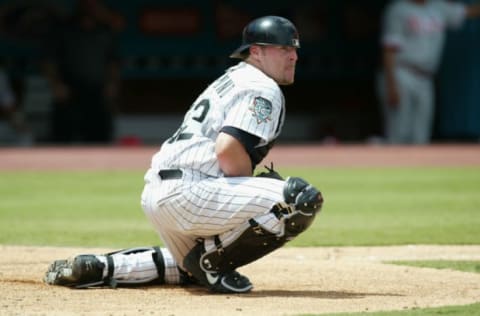
1. Mike Redmond
Mike Redmond is the best backup catcher the Marlins have ever had, bar none. Long before his three-season turn as the Miami Marlins manager, Redmond was the Marlins backup catcher for seven seasons.
After going undrafted in 1992, the Marlins signed Redmond to a contract through free agency, then watched him make his debut six years later. In 2816 total chances behind the plate, Redmond made only 17 errors for a .994 fielding percentage. In his first five seasons, he threw out 39 percent of baserunners, well above the NL average for that period.
Redmond served as the backup for Gregg Zaun in 1998, split the catching duties in 1999 with Jorge Fabregas, split again in 2000 with Paul Bako and Ramon Castro, backed up Charles Johnson in 2001 and 2002 and Ivan Rodriguez in 2003, and split with Paul Lo Duca and Castro in 2004.
More from Marlins History
- Miami Marlins One-Year Wonder 1B
- Miami Marlins players & the 2023 Hall of Fame
- Former Miami Marlins star is retiring
- Gary Sheffield or Mark Buehrle, will either Marlin make the Hall of Fame?
- Why don’t we see more dynasties? Part 3
Redmond was far and away the best hitter from amongst the group listed here in this article. He put up a .284/.348/.362 slashline in 484 games, with 11 home runs and 132 RBI. He hit over .300 in four of his seasons in Miami, and hit the mark again in the two seasons following his movement to the Minnesota Twins through free agency in 2005.
Redmond went on to play in the familiar role of backup catcher for the Twins for the next five seasons before playing in 22 games for the Cleveland Indians in 2010. He would go on to earn a 155-207 record managing the Marlins from 2013 through 2015, but he will always be thought of as the best and longest-serving backup catcher for the Marlins franchise.
Next. What to do with Jordan Yamamoto?. dark
Thanks for reading. Like us on Facebook, follow us on Twitter, and subscribe to our daily newsletter to keep up with the Miami Marlins.